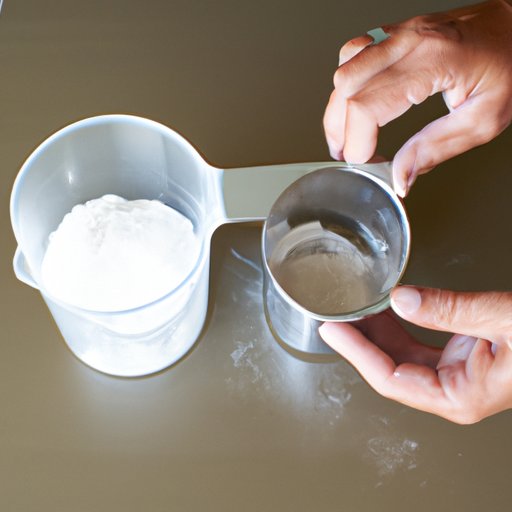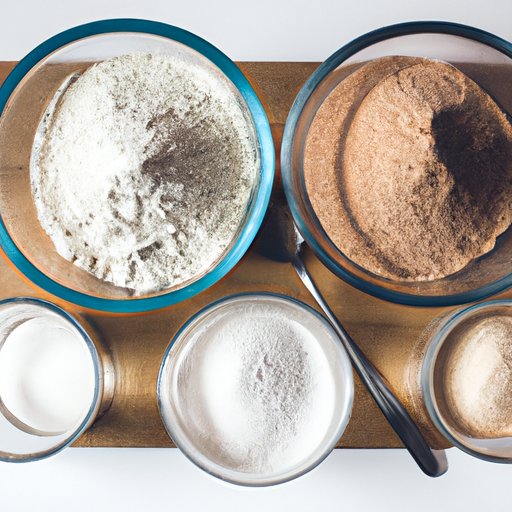Introduction
When it comes to successful baking, accuracy is key. Many recipes call for precise measurements of ingredients, and flour is no exception. However, measuring flour accurately can be a challenge. Different flours can have different weights, and measuring cups can vary in size. In this article, we will explore how many grams are in a cup of flour and why measuring by weight is more accurate than measuring by volume.
Baking Basics: Understanding Flour Measurements by the Gram
Baking requires a variety of different measurements, including grams, ounces, and cups. Each type of measurement has its own importance and purpose. When it comes to flour, many professional bakers and chefs recommend using weight measurements, such as grams or ounces, instead of volume measurements, such as cups.
The reason for this is simple: measuring by weight is more accurate than measuring by volume. Weight measurements do not change, regardless of external factors such as humidity or temperature. On the other hand, measuring by volume can be affected by these factors, resulting in inconsistent measurements and potentially ruined baked goods.
However, there are advantages and disadvantages to each method of measurement. Measuring by volume is easier and more convenient for many home bakers, and can work well in some situations. Ultimately, the choice between measuring by weight or volume comes down to personal preference and the specific recipe being used.

Converting Cups to Grams: How to Get Accurate Flour Measurements
For those who choose to measure flour by weight, it is important to know how to convert cups to grams accurately. Fortunately, it is a relatively simple process that can be done using a digital kitchen scale and a conversion chart.
Different types of flour will have slightly different conversion rates. All-purpose flour, for example, typically weighs about 125 grams per cup, while cake flour is closer to 115 grams per cup. Bread flour, meanwhile, is a bit denser and weighs around 135 grams per cup.
To convert cups to grams, simply place your bowl or measuring cup on the scale and tare it to zero. Then, add the flour until you have reached the desired weight in grams. Double check the weight to ensure accuracy, and adjust as necessary.
If you are having trouble with your conversions, make sure you are using the correct type of flour and double-check your measurements. It can be helpful to use a dedicated baking scale that is calibrated for accuracy.
The Secret to Perfect Baking: Knowing How Many Grams are in a Cup of Flour
Knowing how many grams are in a cup of flour is essential for achieving the best possible results in your baking. While the conversion rates will vary depending on the type of flour, there are some guidelines you can follow.
Here are the approximate grams per cup for some commonly used flours:
– All-purpose flour: 125 grams per cup
– Cake flour: 115 grams per cup
– Bread flour: 135 grams per cup
– Self-rising flour: 125 grams per cup
It is important to note that measuring flour by volume alone can be inaccurate, due to varying densities and compaction levels. It is always best to measure by weight using grams or ounces for the most precise results.
The Science of Flour: Understanding the Importance of Accurate Measurements in Baking
Measuring flour accurately can make a big difference in the final product of your baking. Variations in flour measurements can impact the texture, rise, and overall quality of your baked goods.
One reason why weight measurements are more accurate than volume measurements is due to the compaction of the flour. When measuring by volume, flour can become compacted or settle in the measuring cup, resulting in inaccurate measurements. This can lead to dense or dry baked goods.
In addition, accurate measurements are important for proper gluten development and hydration. Gluten development is essential for the structure and stability of baked goods, while hydration levels impact the texture and overall quality of the end product.
Maximizing Your Flour Measurements: Using Grams Instead of Cups
While it may take a bit more effort to measure flour by weight using grams or ounces, the benefits can be significant. Using weight measurements can lead to more consistent and precise baked goods every time. This is particularly important for professional bakers, who rely on precision to create high-quality products.
Using measuring cups can be easier and quicker, but it can also lead to inconsistent results. Each cup can vary in size and shape, and measuring flour by volume alone can result in inaccurate measurements.
When making the transition to measuring flour by weight, it is important to start with a good kitchen scale and a reliable conversion chart. Be sure to check your measurements frequently to ensure accuracy, and adjust as necessary.
Mastering Flour Measurements: Tips and Tricks for Accurately Measuring by the Gram
Measuring flour accurately can take a bit of practice, but there are some tips and tricks that can help. Here are a few to keep in mind:
– Tare your scale: Place your bowl or measuring cup on the scale and press the tare button to zero it out. This will allow you to measure the flour without including the weight of the container.
– Spoon and level: Use a spoon to add the flour to your measuring cup, then level off the top with a flat edge. This can help prevent over-packing and ensure consistency.
– Use a dedicated baking scale: A high-quality baking scale can make a big difference in achieving precise measurements. Look for one that is calibrated for accuracy and has a tare function.
Conclusion
Measuring flour accurately is essential for successful baking. While measuring by volume using cups can be convenient, it is not always accurate. Measuring by weight using grams or ounces is more precise and consistent, and can lead to better results every time.
By following the above tips and tricks, you can master the art of measuring flour by the gram and achieve perfect baked goods every time.
